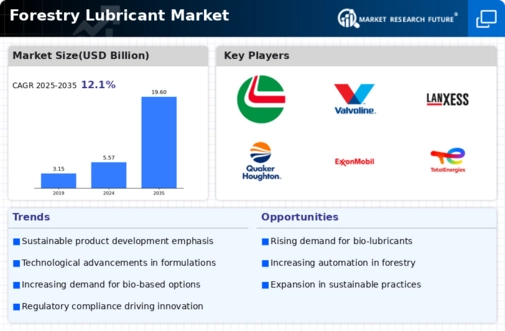Market Growth Projections
The Global Forestry Lubricant Market Industry is poised for substantial growth, with projections indicating a market value of 5.57 USD Billion in 2024 and an anticipated increase to 19.6 USD Billion by 2035. This growth trajectory reflects a compound annual growth rate of 12.13% from 2025 to 2035, driven by various factors such as technological advancements, increased investment in forestry equipment, and rising demand for sustainable practices. The market's expansion is indicative of the evolving landscape of forestry operations, where the integration of high-performance lubricants plays a crucial role in enhancing efficiency and sustainability.
Rising Demand for Sustainable Practices
The Global Forestry Lubricant Market Industry is experiencing a notable shift towards sustainable practices in forestry operations. As environmental regulations become more stringent, the demand for eco-friendly lubricants is increasing. These lubricants are formulated to minimize environmental impact while maintaining high performance. For instance, many forestry companies are now adopting biodegradable lubricants to comply with regulations and enhance their sustainability profiles. This trend is expected to contribute significantly to the market's growth, with projections indicating a market value of 5.57 USD Billion in 2024, reflecting the industry's commitment to sustainable forestry practices.
Growing Awareness of Equipment Maintenance
Awareness regarding the importance of equipment maintenance is a key driver in the Global Forestry Lubricant Market Industry. Forestry operators are increasingly recognizing that proper lubrication is essential for extending the lifespan of machinery and preventing costly breakdowns. This understanding is leading to a greater emphasis on using high-quality lubricants that meet specific operational requirements. Consequently, the demand for specialized forestry lubricants is on the rise, as companies seek to optimize their equipment performance. This trend is likely to contribute to the overall growth of the market, aligning with the projected increase in market value over the coming years.
Increased Investment in Forestry Equipment
The Global Forestry Lubricant Market Industry is benefiting from increased investments in forestry equipment. As the demand for timber and wood products rises, companies are upgrading their machinery to enhance productivity and efficiency. This trend leads to a higher consumption of lubricants, as modern equipment requires specialized formulations to operate optimally. The market is projected to expand significantly, with estimates suggesting a growth to 19.6 USD Billion by 2035. This investment surge not only boosts lubricant sales but also encourages manufacturers to innovate and develop products tailored to the evolving needs of the forestry sector.
Regulatory Compliance and Safety Standards
Regulatory compliance and safety standards are pivotal factors influencing the Global Forestry Lubricant Market Industry. Governments worldwide are implementing stringent regulations to ensure the safe use of lubricants in forestry operations. These regulations often mandate the use of environmentally friendly products, driving the demand for compliant lubricants. Companies that adhere to these standards not only avoid penalties but also enhance their reputation in the market. As a result, the focus on regulatory compliance is expected to propel the growth of the forestry lubricant market, aligning with the anticipated increase in market value and demand for sustainable products.
Technological Advancements in Lubricant Formulation
Innovations in lubricant formulation are driving growth in the Global Forestry Lubricant Market Industry. Advanced technologies are enabling the development of high-performance lubricants that offer superior protection and efficiency. For example, the introduction of synthetic lubricants has revolutionized the market by providing enhanced lubrication properties and extended service life. These advancements not only improve equipment performance but also reduce maintenance costs for forestry operations. As a result, the market is poised for substantial growth, with a projected compound annual growth rate of 12.13% from 2025 to 2035, indicating a strong future for technologically advanced forestry lubricants.



















